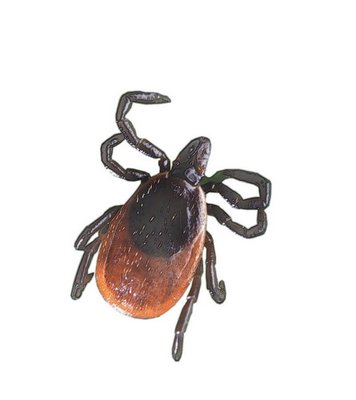

I had been sick for several days but the symptoms seemed to change, then repeat.
At first I just felt like I was getting a cold. But then the chills set in and I felt feverish. That would fade and for a few hours I’d feel fine. Then the cycle would repeat. Over a period of days the symptoms got worse, I had a fever of 102 and I felt freezing cold under multiple blankets. The next day I was admitted to Southampton Hospital as my symptoms worsened.
The doctors were stumped and I clearly remember the feeling that my life was leaving my body. It was the closest I’d come to a near-death experience. Blood samples went to Stony Brook University, but the results were slow in coming as some of the tests like those for Lyme disease were relatively new and not always accurate.
At the end of my third day in the hospital my temperature had topped at nearly 103 degrees. My doctor finally had a diagnosis based on the blood tests, and I then knew I had not just Lyme disease but babesiosis. Both, presumably shared with me as a result of a bite from a deer tick. This was nearly 40 years ago. I had unwittingly become one of only a handful of East End residents to contract Lyme, and I also had the distinction of being one of the first locals with babesiosis. The nature boy had met his match.
There was little question where I had come into contact with the tick. On a daily basis I walked through an uncut grassy meadow that was once part of the Shinnecock Golf Course just off St. Andrews Road West in Shinnecock Hills. In addition to my house being located there, it was also the home to numerous deer, countless mice, red foxes and plenty of birds. All the ingredients needed for a widespread tick outbreak.
Needless to say I am very, very careful these days when it comes to tick exposure. But, being a horticulturist and naturalist who can often be found plant exploring in areas that ticks love, I take precautions. When Lymerix, a Lyme vaccine, was still available, I got the shot. But by the time I was due for the booster the product had been taken off the market. And last summer there was a lot of attention paid to ticks in the media, but there was an amazing amount of bad information going around.
I want to chime in and offer you some of my thoughts and some of the science. Gardeners need to know where you are likely to come into contact with ticks, how to avoid them and steps you can take to reduce their presence on your property.
I do not worry about picking up ticks on my lawn or in my gardens. In my 40-plus years of living with ticks I have never picked one up in a garden (but you can) or from rolling on the lawn with my dog (but you can). Each tick encounter I’ve had was in an area like a meadow, in or near the woods or while walking through the dunes on the way to the beach. Each of these areas is critical spot where ticks lie in wait and where deer, mice and other rodents are plentiful. Add birds to the mix and you have the main ways that ticks get around and get that all important meal of blood that they need to survive. And you, not coincidentally, are also the source of that blood meal that these ticks need for their survival.
Here, we need to dispel a myth. Ticks do not jump. I always hear people relate that a tick jumped on to them. They don’t and they can’t. Ticks simply don’t have the physiology to jump. However, what they can do is lie in wait. Patiently, for as long as two weeks, a tick will sit on a tall meadow grass, twig, blade of beach grass or other spot where deer and other animals (us) frequently pass. They probably sense our body heat or movement as they wait with their front legs extended. They simply wait to be rubbed against and like Velcro they stick to your clothes or your shoes.
More often than not they are fairly close to the ground and will latch on to your pants, shirt sleeve or shoes. Then the journey begins. They slowly move about looking for a place to get access to your skin. Up a pant leg, under a waistband, over a sock, up a sleeve or over your collar. It may take a tick hours to find your skin, but they do. And then they look for a place that’s warm and dark where they begin to insert their mouthparts, inject an anticoagulant and begin to feed.
This can take place on your neck, behind your knees, on your thigh, in your pubic area, in your arm pit or on your head. It takes at least 24 hours for them to make a good attachment and start to feed so if you find a tick quickly your chances of getting an infection are very slim.
When you do find a tick attached to you it needs to be properly removed. Don’t grab it with your fingers and pull. Use a special tick removal tool or sharp tweezers and get the tick out from its mouth parts, not its body. Save the tick by folding it between a piece of tape so it can’t crawl out, write the date on the tape and save the tick in case you need to have it identified as there are several types of ticks and each gifts a different variety of diseases.
Protect yourself! While you may not like putting chemicals on your body, the two most effective chemicals for keeping ticks off you are DEET and permethrin. Trust me, you don’t want to have to put up with Lyme or any of the 87 other tick diseases that we currently know about. DEET can go on your skin and clothes—including your hat. Repellents with 30 percent DEET will give you several hours of protection but there are precautions with children and keeping DEET out of your eyes.
Permethrin can be sprayed on your clothes and should never be sprayed on your skin. It binds to fabrics and can remain active through several washings and for several weeks. It’s available both as a spray and a liquid, and I make sure my pants are sprayed as well as my boots or shoes.
Should you spray your lawn and woods for ticks? Probably not. Organic tick controls are not very effective and spraying your property with chemical tick sprays will kill lots more than ticks, including most of our beneficial insects. Instead use a product like Damminix tick tubes, which are shown to be highly effective when used as directed. Also control your mouse population and—as cute as they are—the chipmunks also. Make sure your cats and dogs are protected.
There’s a great deal of information available online that will tell you how to reduce tick issues on your property and this is a good, comprehensive place to start: https://bit.ly/2KfNCf5.
Some are as simple as keeping a wood pile far from the house as these are habitats for rodents that carry the ticks. Keep your grass mowed to 3 inches and not taller. Avoid meadows and the dunes unless you have a repellent on. If a tick has been attached to you for more than 36 hours, let your doctor know. The July issue of Consumer Reports has excellent information on ticks and tick repellents.
You don’t have to live in fear, but you do need to stay healthy. Garden, explore and go to the beach. But be smart, protect yourself and, of course, keep growing.
 More Posts from Andrew Messinger
More Posts from Andrew Messinger